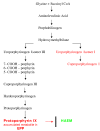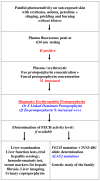Erythropoietic protoporphyria
- PMID: 19744342
- PMCID: PMC2747912
- DOI: 10.1186/1750-1172-4-19
Erythropoietic protoporphyria
Abstract
Erythropoietic protoporphyria (EPP) is an inherited disorder of the haem metabolic pathway characterised by accumulation of protoporphyrin in blood, erythrocytes and tissues, and cutaneous manifestations of photosensitivity. EPP has been reported worldwide, with prevalence between 1:75,000 and 1:200,000. It usually manifests in early infancy upon the first sun exposures. EPP is characterised by cutaneous manifestations of acute painful photosensitivity with erythema and oedema, sometimes with petechiae, together with stinging and burning sensations upon exposure to sunlight, without blisters. These episodes have a variable severity depending on the exposure duration and may result in chronic permanent lesions on exposed skin. As protoporphyrin is a lipophilic molecule that is excreted by the liver, EPP patients are at risk of cholelithiasis with obstructive episodes, and chronic liver disease that might evolve to rapid acute liver failure. In most patients, EPP results from a partial deficiency of the last enzyme of the haem biosynthetic pathway, ferrochelatase, EC 4.99.1.1/FECH (encoded by the FECH gene). EPP appears to be inherited as an autosomal dominant disease, the clinical expression of which is modulated by the presence of the hypomorphic FECH IVS3-48C allele trans, but recessive inheritance with two mutated FECH alleles has also been described. In about 2% of patients, overt disease was recently shown to be caused by gain-of-function mutations in the erythroid-specific aminolevulinic acid synthase 2 (ALAS2/ALAS, EC 2.3.1.27) gene and named X-linked dominant protoporphyria. Diagnosis is established by finding increased levels of protoporphyrin in plasma and red blood cells, and detection of a plasma fluorescence peak at 634 nm. Investigations for hepatic involvement, ferrochelatase activity level, genetic analysis (FECH mutations, presence of the hypomorphic FECH IVS3-48C allele trans and ALAS2 mutations) and family studies are advisable. Differential diagnosis includes phototoxic drug reactions, hydroa vacciniforme, solar urticaria, contact dermatitis, angio-oedema and, in some cases, other types of porphyria. Management includes avoidance of exposure to light, reduction of protoporphyrin levels and prevention of progression of possible liver disease to liver failure. As the major risk in EPP patients is liver disease, a regular follow-up of hepatic involvement is essential. Sequential hepatic and bone marrow transplantation should be considered as a suitable treatment for most severe cases of EPP with hepatic involvement. EPP is a lifelong disorder whose prognosis depends on the evolution of the hepatic disease. However, photosensitivity may have a significant impact on quality of life of EPP patients.
Figures






Similar articles
-
[Inheritance in erythropoietic protoporphyria].Pathol Biol (Paris). 2010 Oct;58(5):372-80. doi: 10.1016/j.patbio.2010.01.007. Epub 2010 Sep 20. Pathol Biol (Paris). 2010. PMID: 20850938 Review. French.
-
The molecular genetics of erythropoietic protoporphyria.Cell Mol Biol (Noisy-le-grand). 2009 Jul 1;55(2):118-26. Cell Mol Biol (Noisy-le-grand). 2009. PMID: 19656460 Review.
-
Late presentation of erythropoietic protoporphyria: case report and genetic analysis of family members.Br J Dermatol. 2007 Nov;157(5):1030-1. doi: 10.1111/j.1365-2133.2007.08117.x. Epub 2007 Aug 17. Br J Dermatol. 2007. PMID: 17711525
-
Congenital erythropoietic porphyria and erythropoietic protoporphyria: Identification of 7 uroporphyrinogen III synthase and 20 ferrochelatase novel mutations.Mol Genet Metab. 2019 Nov;128(3):358-362. doi: 10.1016/j.ymgme.2018.08.015. Epub 2018 Aug 31. Mol Genet Metab. 2019. PMID: 30454868
-
Genetic study in a Singaporean patient with erythropoietic protoporphyria.Photodermatol Photoimmunol Photomed. 2012 Oct;28(5):269-71. doi: 10.1111/j.1600-0781.2012.00685.x. Photodermatol Photoimmunol Photomed. 2012. PMID: 22971195
Cited by
-
Experimental protoporphyria: effect of bile acids on liver damage induced by griseofulvin.Biomed Res Int. 2015;2015:436319. doi: 10.1155/2015/436319. Epub 2015 Apr 7. Biomed Res Int. 2015. PMID: 25945334 Free PMC article.
-
Predicting the impact of diet and enzymopathies on human small intestinal epithelial cells.Hum Mol Genet. 2013 Jul 1;22(13):2705-22. doi: 10.1093/hmg/ddt119. Epub 2013 Mar 13. Hum Mol Genet. 2013. PMID: 23492669 Free PMC article.
-
Peptide-Oligonucleotide Conjugation: Chemistry and Therapeutic Applications.Curr Issues Mol Biol. 2024 Sep 30;46(10):11031-11047. doi: 10.3390/cimb46100655. Curr Issues Mol Biol. 2024. PMID: 39451535 Free PMC article. Review.
-
Blood cytopenias as manifestations of inherited metabolic diseases: a narrative review.Orphanet J Rare Dis. 2024 Feb 14;19(1):65. doi: 10.1186/s13023-024-03074-4. Orphanet J Rare Dis. 2024. PMID: 38355710 Free PMC article. Review.
-
Ferrochelatase is a therapeutic target for ocular neovascularization.EMBO Mol Med. 2017 Jun;9(6):786-801. doi: 10.15252/emmm.201606561. EMBO Mol Med. 2017. PMID: 28377496 Free PMC article.
References
-
- Magnus IA, Jarret A, Prankerd TAJ, Rimington C. Erythropoietic protoporphyria: a new porphyria syndrome with solar urticaria due to protoporphyrinæmia. Lancet. 1961;278:574–581. - PubMed
-
- Cox TM. Protoporpnhyria. In: Kadish KM, Smith KM, Guilard R, editor. The Porphyrin Handbook Medical Aspects of Poprhyrias, Chap 90. Vol. 14. Academic Press. San Diego; 2003. pp. 121–149.
-
- Whatley SD, Ducamp S, Gouya L, Grandchamp B, Beaumont C, Badminton MN, Elder GH, Holme SA, Anstey AV, Parker M, Corrigall AV, Meissner PN, Hift RJ, Marsden JT, Ma Y, Mieli-Vergani G, Deybach JC, Puy H. C-terminal deletions in the ALAS2 gene lead to gain of function and cause X-linked dominant protoporphyria without anemia or iron overload. Am J Hum Genet. 2008;83:408–14. doi: 10.1016/j.ajhg.2008.08.003. - DOI - PMC - PubMed
-
- Elder GH, Smith SG, Smyth SJ. Laboratory investigation of the porphyrias. Ann Clin Biochem. 1990;27:395–412. - PubMed
Publication types
MeSH terms
Substances
LinkOut - more resources
Full Text Sources
Other Literature Sources
Research Materials

